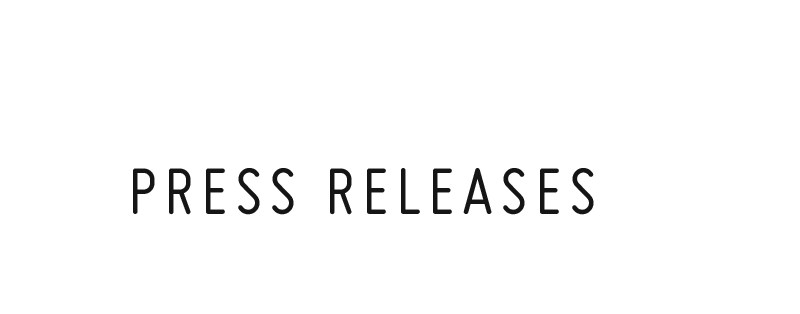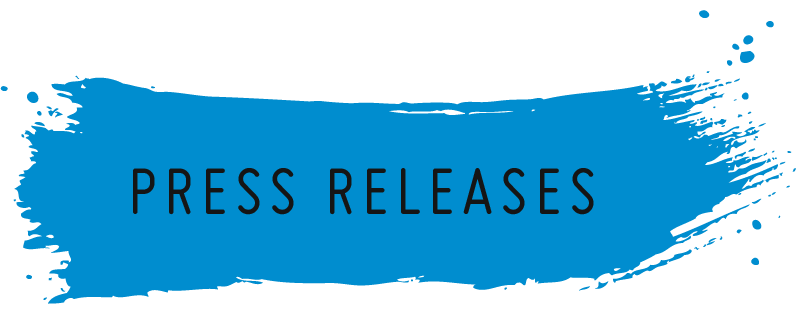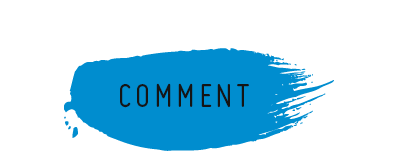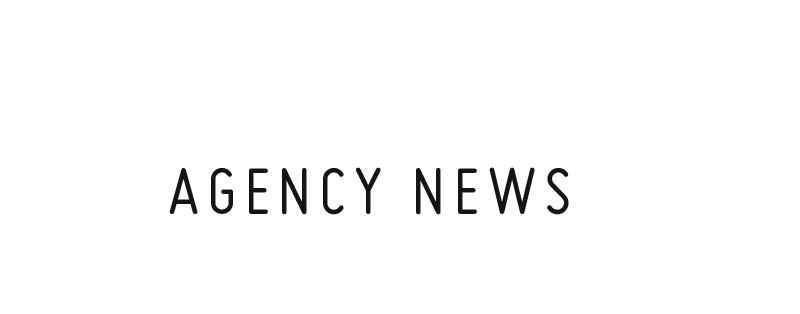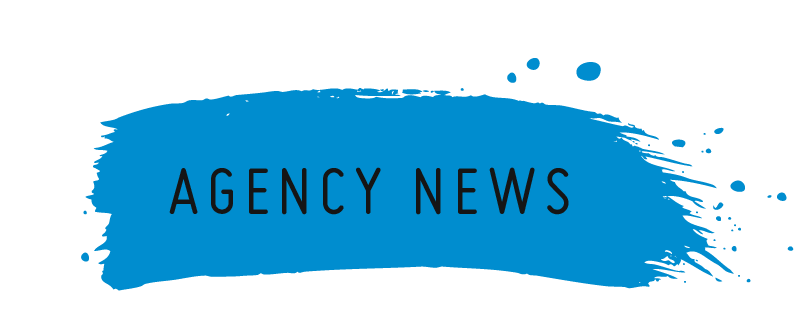- 3D Print Bureau
- 6K
- Agmatix
- Airwayz
- AM-Flow
- Appadda
- Caracol
- CG Trader
- CyberOptics
- e-Xstream
- GenCell
- GreenEye
- Impossible Objects
- Incus Media
- InkBit
- ITG
- JPB Systeme
- KeyProd
- Landa
- LEO Lane
- Lumet
- Magic Software
- MakerBot
- Marketiger
- Nano Dimension
- Paragon Rapid Technologies
- PearlX
- Plant & Bean
- Redefine Meat
- Replique
- Ripples
- Sakuu Corporation
- SolarEdge
- StoreDot
- Stratasys
- Sunrock
- The Bespoke Group
- Trigo
- UltiMaker
- Xjet
MEDICAL CUSTOMERS ACROSS THE GLOBE ADOPT STRATASYS J750 DIGITAL ANATOMY 3D PRINTER
3D-printed anatomical models replicate biomechanics of human anatomy to help improve training, transform surgical planning and bring new medical innovations to market faster
EDEN PRAIRIE, Minn. & REHOVOT, Israel, Nov. 3, 2020 – A year after the launch of its J750™ Digital Anatomy™ 3D printer, Stratasys Ltd. (NASDAQ: SSYS) today announced it has successfully sold and installed the system at healthcare institutions and medical service providers in major markets across the globe, including the United States, China, Italy, Spain, and Australia. Seattle Children’s Hospital, VA Health Care System, Nicklaus Children’s Hospital in Miami, Medilife and BIO3DModel in Italy, and Tknika and AIJU in Spain all recently turned to the innovative new system to help improve patient care and accelerate medical innovation.
The J750 Digital Anatomy 3D printer produces anatomical models that mimic the actual feel, responsiveness, and biomechanics of human anatomy. Models can be punctured, sutured, cut, and physically manipulated like actual human tissue. This capability minimizes the use of animals and cadavers for clinical trials and surgical training. Hospitals, healthcare institutions and medical schools can use these lifelike 3D models to improve clinical evaluation for a wide range of pathologies, as well as bring new medical devices to market faster.
Seattle Children’s Hospital purchased a J750 Digital Anatomy 3D printer early this year and installed it in its new 3D Printing Lab. A major motivation for getting the printer was the ability to create very soft models in-house to duplicate things like airways, livers, and hearts. “The earliest prints using TissueMatrix material were instrumental for understanding the optimal fit for a custom tracheostomy tube, something that would have been impossible with the best materials that we had access to only six months ago,” said Seth Friedman, Ph.D, Manager of Innovation Imaging and Simulation Modeling in the Improvement and Innovation Department. “I believe that by making models in parallel to a patient’s care journey we can truly make a difference. Now integrated into a systemic program called Custom Care, we have little doubt this new technology will help us provide the best care possible to our patients and families.”
Nicklaus Children’s Hospital upgraded to the new J750 Digital Anatomy 3D printer from an existing Eden 260 in the Cardiovascular Surgery Program. The upgrade was a collaboration between the NCHS Personalized Medicine Initiative and the Cardiovascular Surgery Advanced Research Projects Laboratory and was made possible by the support of the Bailey Foundation and donors to NCHS.
Dr. Redmond Burke, chief of Cardiovascular Surgery and co-director of the Heart Program, said it’s now a critical part of surgical planning. “It’s very valuable to be able to actually cut open a model to get a very clear vision of what we’ll see in the operating room,” he said. “We believe this is a significant advance that will allow us to reduce the trauma of patients undergoing complex heart surgery.” He said the new 3D printer also opens up completely new avenues in teaching and patient care.
In Spain, two technology institutions have invested in the Digital Anatomy 3D printer to pioneer their medical service offering. Both cite the unrivalled ultra-realism and tactile nature of the models as a significant competitive advantage.
Nacho Sandoval, Additive Manufacturing Lead at AIJU, said, “Previously, we could not produce models replicating the organic materials frequently requested by the medical sector, let alone realistically simulating the behaviors of human tissue. What is also remarkable is that the precision of the Digital Anatomy printer offers higher resolutions than those obtained with a CT or MRI, which are usually above half a millimeter. We’re already seeing vast interest from a wide range of medical practitioners for these types of models in real-world applications.”
Gorka Baqueriza, Additive Manufacturing Project Manager, Tknika, added: “We see this technology having a significant impact in several areas of healthcare – from medical training to pre-surgery planning to patient care. The level of realism that can be achieved for such a wide range of anatomical models and pathologies is incredible.”
In Italy, President of BIO3DModel, Eng. Roberto Rizzo, said he has witnessed particular interest in the Digital Anatomy 3D printer for surgical training. “This technology enables a drastic reduction in time training surgeons, in particular the ability to investigate for any specific pathological conditions prior to the actual surgery,” he stated. “For example, until now it was not possible to produce hollow vascular systems down to 1mm wall thickness and diameter. This incredible detail could be the difference between life or death for a patient.”
Emanuele D’Angeli, General Manager, Medilife, adds: “The models produced on the Digital Anatomy 3D printer offer the same soft touch and variable density of actual human tissues and organs, which today is impossible to achieve with any other existing 3D printing technology. We are currently testing several applications, including the creation of an artificial limb. The aim is to reproduce the natural external appearance of the limb in terms of texture and color shade, while also replicating the lifelike physical feel that we experience with human touch.”
More information on the J750 Digital Anatomy 3D printer is available online. In addition, Dr. Burke shared his experience with the new 3D printer on YouTube.
-
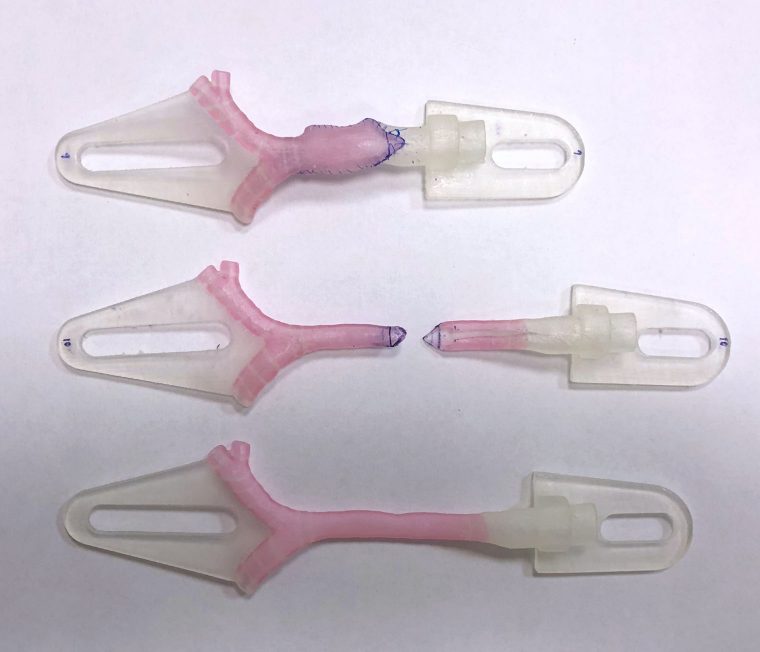 3D-printed models showing virtual surgical planning for a slide tracheoplasty procedure. Courtesy Seattle Children's Hospital.
3D-printed models showing virtual surgical planning for a slide tracheoplasty procedure. Courtesy Seattle Children's Hospital.
Click here to download 300dpi images -
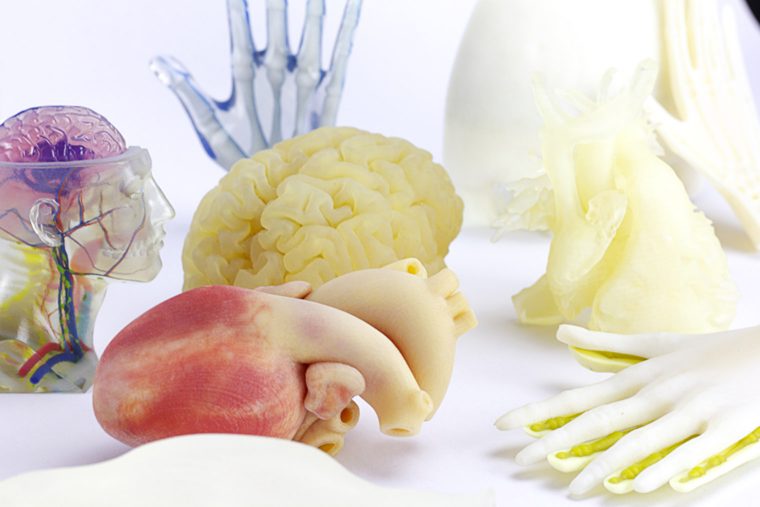 The J750 Digital Anatomy 3D printer offers a level of realism that allows innovation to aid both medical training and pre-surgical planning. Image courtesy AIJU
The J750 Digital Anatomy 3D printer offers a level of realism that allows innovation to aid both medical training and pre-surgical planning. Image courtesy AIJU
Click here to download 300dpi images -
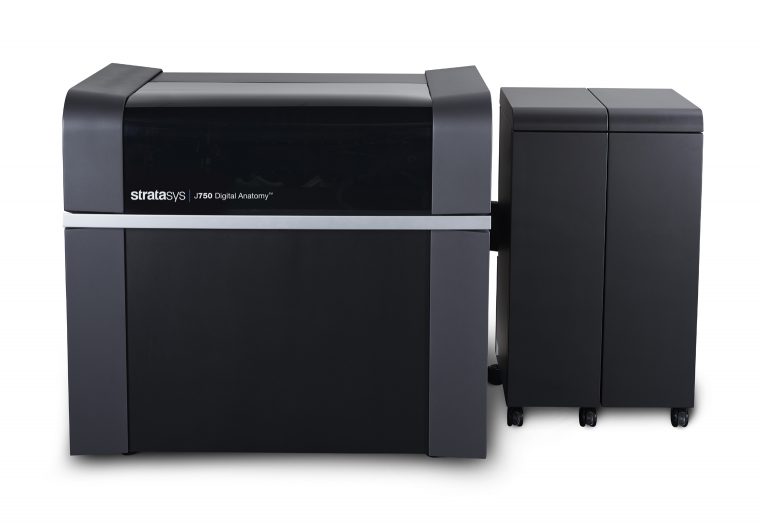 The Stratasys J750 Digital Anatomy 3D printer
The Stratasys J750 Digital Anatomy 3D printer
Click here to download 300dpi images
DES CLIENTS DU SECTEUR MÉDICAL DU MONDE ENTIER ADOPTENT L'IMPRIMANTE 3D J750 DIGITAL ANATOMY DE STRATASYS
Les modèles anatomiques imprimés en 3D reproduisent la biomécanique de l’anatomie humaine dans le but d’améliorer la formation, de transformer la planification chirurgicale et de commercialiser plus rapidement les innovations médicales
EDEN PRAIRIE, Minn. & REHOVOT, Israël, 3 nov. 2020 – Un an après le lancement de son imprimante 3D J750™ Digital Anatomy™, Stratasys Ltd. (NASDAQ : SSYS) a annoncé aujourd’hui qu’elle avait vendu et installé avec succès le système dans des établissements de santé et chez des prestataires de services médicaux sur les principaux marchés du monde, notamment aux États-Unis, en Chine, en Italie, en Espagne et en Australie. L’hôpital pour enfants de Seattle, l’hôpital pour enfants Nicklaus de Miami, Medilife et BIO3DModel en Italie, ainsi que Tknika et AIJU en Espagne ont adopté récemment ce système novateur, pour améliorer les soins aux patients et accélérer l’innovation médicale.
L’imprimante 3D J750 Digital Anatomy produit des modèles anatomiques qui imitent l’ergonomie, la réactivité et la biomécanique réelles de l’anatomie humaine. Les modèles peuvent être percés, suturés, coupés et manipulés physiquement comme de véritables tissus humains. Ces capacités permettent de réduire l’utilisation d’animaux et de cadavres pour les essais cliniques et la formation chirurgicale. Les hôpitaux, les établissements de santé et les écoles de médecine peuvent utiliser ces modèles 3D plus vrais que nature pour améliorer l’évaluation clinique d’un large éventail de pathologies, ainsi que pour accélérer la commercialisation de nouveaux dispositifs médicaux.
L’hôpital pour enfants de Seattle a acheté une imprimante 3D J750 Digital Anatomy au début de l’année et l’a installée dans son nouveau laboratoire d’impression 3D. L’une des principales raisons de cet achat a été la capacité de l’imprimante à créer des modèles très flexibles en interne, pour reproduire des organes comme les voies aériennes, le foie et le cœur. « Les premières impressions avec le matériau TissueMatrix ont été essentielles pour comprendre l’ajustement optimal d’un tube de trachéostomie personnalisé, ce qui aurait été impossible avec les meilleurs matériaux auxquels nous avions accès il y a seulement six mois », a déclaré Seth Friedman, Ph.D., responsable de l’innovation en imagerie et de la modélisation de simulation au sein du département Amélioration et Innovation. « Je suis convaincu que la création de modèles parallèlement au parcours de soins d’un patient peut vraiment faire toute la différence. Désormais intégrée dans un programme systématique appelé « Custom Care », il ne fait plus aucun doute que cette nouvelle technologie nous aidera à fournir les meilleurs soins possibles à nos patients et à leurs familles. »
L’hôpital Nicklaus pour enfants est passée à la nouvelle imprimante 3D J750 Digital Anatomy à partir d’un Eden 260 existant dans le cadre du Programme de Chirurgie Cardiovasculaire.
Le Dr Redmond Burke, directeur de la chirurgie cardiovasculaire et co-directeur du programme cardiaque, a déclaré qu’elle était devenue un élément essentiel de la planification chirurgicale. « Il est très utile de pouvoir découper un modèle pour disposer d’une vision très claire de ce que nous allons voir dans la salle d’opération », a-t-il affirmé. « Nous sommes convaincus qu’il s’agit d’une avancée considérable qui nous permettra de réduire les effets traumatiques sur les patients soumis à une chirurgie cardiaque complexe. » Il a déclaré que la nouvelle imprimante 3D ouvre également de toutes nouvelles voies dans l’enseignement et les soins aux patients.
En Espagne, deux institutions technologiques ont investi dans l’imprimante 3D Digital Anatomy comme fer de lance de leur offre de services médicaux. Dans les deux cas, l’ultra-réalisme et la nature tactile inégalés des modèles sont cités comme des avantages concurrentiels importants.
Nacho Sandoval, responsable de la fabrication additive au sein de l’AIJU, a déclaré : « Auparavant, nous n’étions pas capables de produire des modèles imitant les matériaux organiques les plus fréquemment demandés par le secteur médical, et encore moins simuler de manière réaliste les comportements des tissus humains. Ce qui est également remarquable, c’est que la précision de l’imprimante Digital Anatomy offre des résolutions plus élevées que celles obtenues avec un CT ou une IRM, qui sont généralement supérieures à un demi-millimètre. Nous constatons déjà un intérêt croissant de la part d’un grand nombre de médecins pour ce type de modèles dans les applications du monde réel. »
Gorka Baqueriza, responsable de projet en fabrication additive chez Tknika ajoute, « Selon nous, cette technologie aura un impact significatif dans plusieurs domaines des soins de santé, depuis la formation médicale jusqu’à la planification pré-chirurgicale en passant par les soins aux patients. Le niveau de réalisme que l’on peut atteindre pour un si large éventail de modèles anatomiques et de pathologies est tout simplement incroyable.»
En Italie, le président de BIO3DModel, Eng. Roberto Rizzo, a déclaré avoir constaté un intérêt particulier pour l’imprimante 3D J750 Digital Anatomy dans le domaine de la formation chirurgicale. Selon lui, « cette technologie permet de réduire considérablement la durée de la formation des chirurgiens, en particulier grâce à la possibilité offerte de rechercher des pathologies spécifiques avant l’intervention chirurgicale proprement dite. » « Il était par exemple impossible, jusqu’à présent, de produire des systèmes vasculaires creux présentant une épaisseur de paroi et un diamètre inférieur à 1 mm. La vie ou la mort d’un patient pourrait bien reposer sur ce détail incroyable. »
Emanuele D’Angeli, directeur général, Medilife, ajoute : « Les modèles produits sur l’imprimante 3D Digital Anatomy offrent un toucher doux et une densité variable similaires aux tissus et organes humains réels, ce qu’aucune autre technologie d’impression 3D ne permet de réaliser aujourd’hui. Nous testons actuellement plusieurs applications, dont la création d’un membre artificiel. Notre objectif est de reproduire non seulement l’apparence extérieure naturelle du membre, en termes de texture et de nuance de couleur, mais aussi la sensation physique concrète que nous éprouvons avec le toucher humain. »
Vous trouverez plus d’informations sur l’imprimante 3D J750 Digital Anatomy en ligne. En outre, le Dr Burke a fait part de son expérience avec la nouvelle imprimante 3D sur YouTube.
-
 Modèles imprimés en 3D montrant la planification chirurgicale virtuelle d'une procédure de trachéoplastie. Avec l'aimable autorisation de l'hôpital pour enfants de Seattle.
Modèles imprimés en 3D montrant la planification chirurgicale virtuelle d'une procédure de trachéoplastie. Avec l'aimable autorisation de l'hôpital pour enfants de Seattle.
Click here to download 300dpi images -
 L'imprimante 3D J750 Digital Anatomy offre un niveau de réalisme qui permet l'innovation pour aider à la fois la formation médicale et la planification pré-chirurgicale. Avec l'aimable autorisation de AIJU.
L'imprimante 3D J750 Digital Anatomy offre un niveau de réalisme qui permet l'innovation pour aider à la fois la formation médicale et la planification pré-chirurgicale. Avec l'aimable autorisation de AIJU.
Click here to download 300dpi images -
 L'imprimante 3D J750 Digital Anatomy de Stratasys.
L'imprimante 3D J750 Digital Anatomy de Stratasys.
Click here to download 300dpi images
MEDIZINKUNDEN AUF DER GANZEN WELT ENTSCHEIDEN SICH FÜR DEN 3D-DRUCKER J750 DIGITAL ANATOMY VON STRATASYS
3D-gedruckte anatomische Modelle bilden die Biomechanik der menschlichen Anatomie nach und helfen damit, die Ausbildung zu verbessern, die chirurgische Planung zu optimieren und neue medizinische Innovationen schneller auf den Markt zu bringen
EDEN PRAIRIE, Minnesota & REHOVOT, Israel, 3. Nov. 2020 – Ein Jahr nach der Einführung des J750™ Digital Anatomy™ 3D-Druckers hat Stratasys Ltd. (NASDAQ: SSYS) heute bekanntgegeben, dass das System erfolgreich bei Gesundheitseinrichtungen und medizinischen Dienstleistern in den wichtigsten Märkten der Welt, darunter die Vereinigten Staaten, China, Italien, Spanien und Australien, installiert worden ist. Das Seattle Children’s Hospital, das Nicklaus Children’s Hospital in Miami, Medilife und BIO3DModel in Italien sowie Tknika und AIJU in Spanien haben sich alle vor kurzem dem innovativen neuen System zugewandt, um die Patientenversorgung zu verbessern und die medizinische Innovation zu beschleunigen.
Der J750 Digital Anatomy 3D-Drucker produziert anatomische Modelle, welche die tatsächliche Haptik, die Reaktionsfähigkeit und die Biomechanik der menschlichen Anatomie nachahmen. Die Modelle können wie echtes menschliches Gewebe punktiert, genäht, geschnitten und physisch manipuliert werden. Diese Eigenschaften minimieren den Einsatz von Tieren und Kadavern bei klinischen Studien und chirurgischem Training. Krankenhäuser, Gesundheitseinrichtungen und medizinische Fakultäten können diese lebensechte 3D-Modelle nutzen, um die klinische Bewertung für eine Vielzahl von Pathologien zu verbessern und neue medizinische Hilfsmittel schneller auf den Markt zu bringen.
Das Nicklaus Children’s Hospital hat im Rahmen seines Herzprogramms seine 3D-Druckmöglichkeiten von einem Eden 260 auf einen neuen J750 Digital Anatomy 3D-Drucker erweitert.Das Seattle Children’s Hospital hat Anfang dieses Jahres einen J750 Digital Anatomy 3D-Drucker gekauft und in seinem neuen 3D-Drucklabor installiert. Ein wesentlicher Grund für die Anschaffung des Druckers war die Möglichkeit, im eigenen Haus sehr weiche Modelle zu erstellen, um Organe wie Atemwege, Leber und Herzen zu duplizieren. „Die ersten Drucke mit TissueMatrix™-Material waren entscheidend für das Verständnis der optimalen Passform einer kundenspezifischen Tracheostomiekanüle. Das wäre mit den besten Materialien, die wir noch vor sechs Monaten zur Verfügung hatten, unmöglich gewesen”, sagte Seth Friedman, Ph.D, Manager of Innovation Imaging and Simulation Modeling in the Improvement and Innovation Department. „Ich bin sicher, dass wir wirklich etwas bewirken können, wenn wir Modelle parallel zur Pflege eines Patienten herstellen. Wir sind jetzt in ein systemisches Programm namens Custom Care integriert und haben kaum Zweifel, dass diese neue Technologie uns helfen wird, unseren Patienten und Familien die bestmögliche Versorgung zu bieten.”
Dr. Redmond Burke, Chief of Cardiovascular Surgery und Co-Director des Heart Program, Nicklaus Children’s Hospital, sagte, dies sei jetzt ein wesentlicher Teil der chirurgischen Planung. „Es ist sehr nützlich, ein Modell aufschneiden zu können, um eine sehr klare Vorstellung davon zu erhalten, was wir im Operationssaal sehen werden”, sagte er. „Wir glauben, dass dies ein bedeutender Fortschritt ist, der es uns ermöglicht, das Trauma von Patienten, die sich einer komplexen Herzoperation unterziehen, zu reduzieren.” Er sagte, der neue 3D-Drucker eröffne auch völlig neue Wege in der Lehre und Patientenversorgung.
In Spanien haben zwei Technologiefirmen in den Digital Anatomy 3D-Drucker investiert, um Pionierarbeit für ihr medizinisches Serviceangebot zu leisten. Beide führen den unübertroffenen Ultra-Realismus und die Haptik der Modelle als bedeutenden Wettbewerbsvorteil an.
Nacho Sandoval, Additive Manufacturing Lead bei AIJU, sagte: „Bisher konnten wir keine Modelle herstellen, die die von der Medizin häufig nachgefragten organischen Materialien nachbilden, geschweige denn das Verhalten von menschlichem Gewebe realistisch simulieren. Bemerkenswert ist auch, dass die Präzision des Digital Anatomy 3D-Druckers höhere Auflösungen bietet als die mit einem CT oder MRT erzielten, die normalerweise über einem halben Millimeter liegen. Wir sehen bei einer Vielzahl von Ärzten bereits großes Interesse für diese Art von Modellen in realen Anwendungen.”
Gorka Baqueriza, Additive Manufacturing Project Manager, Tknika, sagte: „Wir bemerken, dass diese Technologie in verschiedenen Bereichen des Gesundheitswesens erhebliche Auswirkungen hat – von der medizinischen Ausbildung über die Planung vor der Operation bis hin zur Patientenversorgung. Der Grad an Realismus, der bei einem so breiten Spektrum anatomischer Modelle und Pathologien erreicht werden kann, ist unglaublich. Wir kennen bereits Fälle, in denen diese Modelle verwendet wurden, um die Durchführbarkeit einer tatsächlichen Operation vorab zu testen.”
In Italien sagte Eng. Roberto Rizzo, President bei BIO3DModel, er habe ein besonderes Interesse an dem Digital Anatomy 3D-Drucker für die chirurgische Ausbildung festgestellt. „Diese Technologie ermöglicht eine erhebliche Verkürzung der Zeit für die Ausbildung von Chirurgen, insbesondere die Möglichkeit, vor der eigentlichen Operation nach bestimmten pathologischen Zuständen zu untersuchen”, erklärte er. „Beispielsweise war es bisher nicht möglich, hohle Gefäßsysteme bis zu einer Wandstärke und einem Durchmesser von 1 mm herzustellen. Dieses unglaubliche Detail kann für einen Patienten den Unterschied zwischen Leben und Tod ausmachen.”
Emanuele D’Angeli, General Manager bei Medilife, fügte hinzu: “Die auf dem Digital Anatomy 3D-Drucker hergestellten Modelle bieten den gleichen weichen Griff und die gleiche variable Dichte von tatsächlichen menschlichen Geweben und Organen, die heute mit keiner anderen 3D-Drucktechnologie erreicht werden können. Wir testen derzeit mehrere Anwendungen, darunter die Erstellung einer künstlichen Extremität. Ziel ist es, das natürliche äußere Erscheinungsbild der Extremität in Bezug auf Textur und Farbton zu reproduzieren und gleichzeitig die lebensechte physische Haptik nachzubilden, das wir bei menschlicher Berührung erleben.”
Weitere Informationen über den J750 Digital Anatomy 3D-Drucker sind online verfügbar. Zudem schildert Dr. Burke seine Erfahrungen mit dem neuen 3D-Drucker auf YouTube.
-
 3D-gedruckte Modelle zur Operationsplanung für ein Trachealplastik-Verfahren. Bildnachweis: Seattle Children's Hospital
3D-gedruckte Modelle zur Operationsplanung für ein Trachealplastik-Verfahren. Bildnachweis: Seattle Children's Hospital
Click here to download 300dpi images -
 Der Grad an Realismus, der mit dem J750 Digital Anatomy 3D-Drucker erreicht werden kann ermöglicht Innovation in der medizinischen Ausbildung als auch in der präoperative Planung. Bildnachweis: AIJU
Der Grad an Realismus, der mit dem J750 Digital Anatomy 3D-Drucker erreicht werden kann ermöglicht Innovation in der medizinischen Ausbildung als auch in der präoperative Planung. Bildnachweis: AIJU
Click here to download 300dpi images -
 Der J750 Digital Anatomy 3D-Drucker
Der J750 Digital Anatomy 3D-Drucker
Click here to download 300dpi images
OPERATORI DEL SETTORE SANITARIO DI TUTTO IL MONDO ADOTTANO LA STAMPANTE 3D J750 DIGITAL ANATOMY DI STRATASYS
I modelli anatomici stampati in 3D replicano le biomeccaniche del corpo umano per contribuire a migliorare la formazione, trasformare la pianificazione chirurgica e accelerare la commercializzazione delle più recenti innovazioni in campo medico.
EDEN PRAIRIE, Minn. e REHOVOT, Israele, 3 novembre 2020 – A un anno dal lancio della stampante 3D J750™ Digital Anatomy™, Stratasys Ltd. (NASDAQ: SSYS) ha annunciato oggi di aver venduto e installato con successo il sistema presso istituzioni sanitarie e fornitori di servizi medici nei principali mercati del mondo, tra cui Stati Uniti, Cina, Italia, Spagna e Australia. Medilife e BIO3DModel in Italia, l’ospedale pediatrico di Seattle e l’ospedale pediatrico Nicklaus di Miami, Tknika e AIJU in Spagna di recente si sono rivolti a questo nuovo sistema per contribuire a migliorare la cura dei pazienti e accelerare l’innovazione in campo medico.
La stampante 3D J750 Digital Anatomy realizza modelli anatomici che riproducono la reale sensibilità, la reattività e le biomeccaniche dell’anatomia umana. I modelli possono essere perforati, suturati, tagliati e manipolati fisicamente come un vero e proprio tessuto umano. Questa capacità riduce al minimo l’uso di animali e di cadaveri per i test clinici e la formazione in ambito chirurgico. Ospedali, istituzioni sanitarie e scuole di medicina possono utilizzare questi realistici modelli tridimensionali per migliorare la valutazione clinica di un’ampia gamma di patologie, oltre a portare più rapidamente sul mercato nuovi dispositivi medici.
In Italia l’ing. Roberto Rizzo, presidente di BIO3DModel, ha dichiarato di essere stato testimone del particolare interesse suscitato dalla stampante 3D J750 Digital Anatomy nel campo della formazione chirurgica. “Questa tecnologia consente di ridurre drasticamente i tempi di formazione dei chirurghi e, in particolare, accresce la capacità di indagare su eventuali condizioni patologiche specifiche prima dell’intervento”, ha dichiarato. “Ad esempio, fino ad oggi non era possibile produrre sistemi vascolari cavi fino a 1 mm di spessore e diametro della parete. Sembra incredibile, ma questo dettaglio potrebbe fare la differenza tra la vita o la morte di un paziente”.
Emanuele D’Angeli, Direttore Generale di Medilife, aggiunge: “I modelli prodotti sulla stampante 3D Digital Anatomy offrono la stessa morbidezza al tatto e la stessa densità variabile dei tessuti e degli organi umani reali, oggi impossibili da ottenere con qualsiasi altra tecnologia di stampa 3D esistente. Attualmente stiamo testando diverse applicazioni, tra cui la creazione di un arto artificiale. L’obiettivo è quello di riprodurre l’aspetto esterno naturale dell’arto in termini di consistenza e tonalità di colore, replicando al tempo stesso la sensazione fisica realistica che si prova con il tocco umano”.
All’inizio di quest’anno, l’ospedale pediatrico di Seattle ha acquistato una stampante 3D J750 Digital Anatomy e l’ha installata nel suo nuovo laboratorio di stampa 3D. Una delle ragioni principali che hanno motivato l’acquisizione della stampante è stata la capacità di creare internamente modelli molto morbidi per riprodurre parti come vie respiratorie, fegato e cuore. “Le prime stampe che utilizzavano materiale TissueMatrix sono state determinanti per capire l’adattamento ottimale di un tubo personalizzato per la tracheostomia, cosa semplicemente impensabile anche con i migliori materiali a cui avevamo accesso solo sei mesi fa”, ha detto Seth Friedman, Ph.D., responsabile dell’innovazione nel campo dell’imaging e della modellazione di simulazione nel reparto per il progresso e l’innovazione. “Credo che creare modelli di pari passo con il percorso di cura del paziente possa davvero fare la differenza. Adesso che è stata integrata in un programma sistemico chiamato Custom Care, siamo praticamente certi che questa nuova tecnologia ci aiuterà a fornire la migliore assistenza possibile ai nostri pazienti e alle famiglie”.
Nel mese di febbraio di quest’anno, l’ospedale pediatrico Nicklaus ha ampliato le sue capacità di stampa 3D installando una nuova stampante J750 Digital Anatomy al posto di un sistema Eden 260 nell’ambito del programma Cardiovascular Surgery Program.
Il dottor Redmond Burke, Direttore di Chirurgia Cardiovascolare e co-direttore del programma Heart Program, ha dichiarato che ora è diventata una parte fondamentale della pianificazione chirurgica. “È molto importante poter tagliare e aprire un modello per avere una visione molto chiara di ciò che ci aspetta in sala operatoria”, ha detto. “Crediamo che questo sia un progresso significativo che ci permetterà di ridurre l’effetto traumatico sui pazienti che subiscono un’operazione cardiaca complessa”. Burke ha inoltre aggiunto che la nuova stampante 3D apre le porte a opportunità inedite in ambito di insegnamento e nella cura del paziente.
In Spagna, due istituzioni tecnologiche hanno investito nella stampante 3D Digital Anatomy per posizionarsi all’avanguardia nell’offerta di servizi medici. Entrambe individuano in un ultra-realismo senza pari e nella natura tattile dei modelli un significativo vantaggio competitivo.
Nacho Sandoval, Additive Manufacturing Lead di AIJU, ha dichiarato: “In precedenza, non potevamo fabbricare modelli capaci di riprodurre i materiali organici frequentemente richiesti dal settore medico, né tanto meno simulare realisticamente i comportamenti dei tessuti umani. Va poi sottolineato che la precisione della stampante Digital Anatomy offre risoluzioni più elevate rispetto a quelle ottenute con una TAC o una risonanza magnetica, che di solito si situano al di sopra di mezzo millimetro. Stiamo già riscontrando un grande interesse da parte di un’ampia fascia di medici per questo tipo di modelli nelle applicazioni del mondo reale”.
Gorka Baqueriza, Additive Manufacturing Project Manager di Tknika, ha commentato: “Riscontriamo un impatto significativo di questa tecnologia su diversi settori della sanità, dalla formazione del personale medico alla pianificazione preoperatoria alla cura del paziente. Il livello di realismo che si può ottenere in una così vasta gamma di modelli anatomici e patologie è incredibile.”
Maggiori informazioni sulla stampante 3D Digital Anatomy sono disponibili online. Inoltre, il Dott. Burke ha condiviso la sua esperienza con la nuova stampante 3D su YouTube.
-
 La stampante 3D J750 Digital Anatomy di Stratasys
La stampante 3D J750 Digital Anatomy di Stratasys
Click here to download 300dpi images -
 Modelli stampati in 3D che mostrano la pianificazione chirurgica virtuale per una procedura di tracheoplastica. Per gentile concessione del Seattle Children's Hospital.
Modelli stampati in 3D che mostrano la pianificazione chirurgica virtuale per una procedura di tracheoplastica. Per gentile concessione del Seattle Children's Hospital.
Click here to download 300dpi images -
 Grazie all’elevato livello di realismo raggiunto dalla stampante 3D J750 Digital Anatomy, questa tecnologia contribuisce a migliorare sia la formazione medica sia la pianificazione pre-chirurgica. Immagine per gentile concessione di AIJU
Grazie all’elevato livello di realismo raggiunto dalla stampante 3D J750 Digital Anatomy, questa tecnologia contribuisce a migliorare sia la formazione medica sia la pianificazione pre-chirurgica. Immagine per gentile concessione di AIJU
Click here to download 300dpi images
CLIENTES DEL SECTOR DE LA MEDICINA DE TODO EL MUNDO ADOPTAN LA IMPRESORA 3D J750 DIGITAL ANATOMY DE STRATASYS
Los modelos anatómicos impresos en 3D replican la biomecánica de la anatomía humana para ayudar a mejorar la formación, transformar la planificación de las intervenciones quirúrgicas y lanzar al mercado las innovaciones médicas con mayor rapidez.
EDEN PRAIRIE, Minnesota (Estados Unidos) y REHOVOT (Israel), 3 de noviembre de 2020 – Un año después del lanzamiento de la impresora 3D J750™ Digital Anatomy™, Stratasys Ltd. (NASDAQ: SSYS) ha anunciado hoy que ha vendido e instalado con éxito el sistema en instituciones sanitarias y proveedores de servicios médicos en los principales mercados de todo el mundo, incluidos Estados Unidos, China, Italia, España y Australia. Tknika y AIJU en España, Seattle Children’s Hospital y Nicklaus Children’s Hospital en Miami, Medilife y BIO3DModel en Italia, han adoptado recientemente este nuevo e innovador sistema para ayudar a mejorar la atención al paciente y acelerar la innovación médica.
La impresora 3D J750 Digital Anatomy fabrica modelos anatómicos que imitan el tacto, la capacidad de respuesta y la biomecánica reales de la anatomía humana. En los modelos se pueden hacer punciones, y se pueden suturar, cortar y manipular físicamente como si fueran tejidos humanos reales. Esta capacidad reduce el uso de animales y cadáveres para realizar pruebas clínicas y formación quirúrgica. Los hospitales, las instituciones sanitarias y las facultades de medicina pueden utilizar estos modelos 3D tan realistas para mejorar la evaluación clínica de una amplia gama de patologías, así como para lanzar al mercado nuevos dispositivos médicos con mayor rapidez.
En España dos instituciones tecnológicas han invertido en la impresora 3D Digital Anatomy para convertirse en pioneras en su oferta de servicios médicos. Ambas resaltan el incomparable ultrarrealismo y los detalles de tacto de los modelos como una ventaja competitiva significativa.
Nacho Sandoval, ingeniero responsable de fabricación aditiva del Instituto Tecnológico del Juguete (AIJU) explica: “Antes no podíamos fabricar modelos que replicaran los materiales orgánicos que se suelen solicitar en el sector médico, y mucho menos que simularan de manera realista el comportamiento del tejido humano. También hay que destacar que la precisión de la impresora Digital Anatomy ofrece resoluciones superiores a las obtenidas con una TC o una RM, que suelen estar por encima del medio milímetro. Ya estamos viendo el gran interés de muchos médicos por este tipo de modelos en aplicaciones del mundo real”.
Gorka Baqueriza, responsable de proyecto de fabricación aditiva de Tknika añade: “Consideramos que esta tecnología tiene un impacto significativo en varias áreas del sector sanitario, desde la formación médica hasta la planificación preoperatoria y la atención al paciente. El nivel de realismo que se puede lograr para tan gama amplia de modelos anatómicos y patologías es increíble”.
La institución Seattle Children’s Hospital adquirió una impresora 3D J750 Digital Anatomy a principios de este año y la ha instalado en su nuevo laboratorio de impresión 3D. Uno de los principales motivos para adquirir la impresora fue la capacidad de crear internamente modelos muy flexibles para replicar elementos como las vías respiratorias, el hígado o el corazón. Las primeras impresiones con el material TissueMatrix fueron fundamentales para comprender el ajuste óptimo de un tubo de traqueotomía personalizado, algo que hubiera sido imposible utilizando los mejores materiales a los que teníamos acceso hace solo seis meses”, afirma el doctor Seth Friedman, Gerente de Imagen de Innovación y Modelado de Simulación del Departamento de Mejora e Innovación. “Creo que al crear modelos en paralelo a la trayectoria de atención de un paciente, realmente podemos marcar la diferencia. Tenemos pocas dudas de que esta nueva tecnología nos ayudará a ofrecer la mejor atención posible a nuestros pacientes y familias, y además la hemos integrado en un programa sistémico denominado Custom Care”.
El pasado mes de febrero, Nicklaus Children’s Hospital amplió sus capacidades de impresión 3D adquiriendo una nueva impresora 3D J750 Digital Anatomy en lugar de un sistema Eden 260 como parte de su programa Cardiovascular Surgery Program.
El doctor Redmond Burke, director de Cirugía Cardiovascular y codirector de Heart Program declaró que ahora es una parte fundamental de la planificación quirúrgica. “Es muy importante poder cortar y abrir un modelo para tener una visión muy clara de lo que nos encontraremos en el quirófano”, añadió. “Creemos que se trata de un avance importante que nos permitirá reducir los problemas de los pacientes que se someten a una intervención cardíaca”. Burke también declaró que la nueva impresora 3D abre la puerta a oportunidades sin precedentes en la enseñanza y el cuidado del paciente.
En Italia, el ingeniero Roberto Rizzo, presidente de BIO3DModel, ha afirmado que ha sido testigo de un especial interés en la impresora 3D J750 Digital Anatomy para la formación quirúrgica. “Esta tecnología permite una reducción drástica en el tiempo de formación de los cirujanos, en particular en la capacidad de investigar problemas patológicos específicos antes de la cirugía”, ha declarado. “Por ejemplo, hasta ahora no era posible fabricar sistemas vasculares huecos de menos de 1 mm de espesor y diámetro de pared. Este increíble detalle podría marcar la diferencia entre la vida o la muerte de un paciente”.
Emanuele D’Angeli, director general de Medilife, añade: “Los modelos fabricados con la impresora 3D Digital Anatomy ofrecen el mismo tacto suave y densidad variable de los tejidos y órganos humanos reales, lo que hoy en día es imposible de lograr con otras tecnologías de impresión 3D existentes. En la actualidad estamos probando varias aplicaciones, entre ellas la creación de una prótesis. El objetivo es reproducir el aspecto externo natural de la extremidad en términos de textura y tono de color, y al mismo tiempo replicar la sensación física realista que experimentamos con el tacto humano”.
Tiene a su disposición más información sobre la impresora 3D J750 Digital Anatomy en línea. Además, el doctor Burke ha compartido su experiencia con la nueva impresora 3D en YouTube.
-
 Modelos impresos en 3D que muestran la planificación quirúrgica virtual para un procedimiento de traqueoplastia. Imagen cortesía del Seattle Children's Hospital.
Modelos impresos en 3D que muestran la planificación quirúrgica virtual para un procedimiento de traqueoplastia. Imagen cortesía del Seattle Children's Hospital.
Click here to download 300dpi images -
 Gracias al alto nivel de realismo alcanzado por la impresora 3D J750 Digital Anatomy, esta tecnología ayuda a mejorar tanto la formación médica como la planificación prequirúrgica. Imagen cortesía de AIJU
Gracias al alto nivel de realismo alcanzado por la impresora 3D J750 Digital Anatomy, esta tecnología ayuda a mejorar tanto la formación médica como la planificación prequirúrgica. Imagen cortesía de AIJU
Click here to download 300dpi images -
 La impresora 3D J750 Digital Anatomy de Stratasys
La impresora 3D J750 Digital Anatomy de Stratasys
Click here to download 300dpi images
